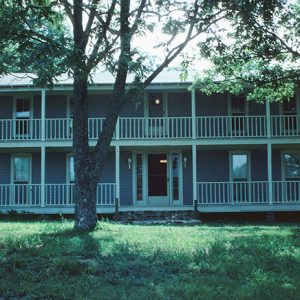calsfoundation@cals.org
Morris House (White County)
aka: Conley-Siler Residence
The pre–Civil War Morris House is one of the oldest surviving rural houses in White County. Constructed along the Military Road in 1860, the house served as a stopover station for many visitors traveling through the state during the early nineteenth century.
In the late 1840s, Henry Patrick Morris, one of four brothers who left Virginia for Arkansas, settled on a farm just north of Searcy (White County) with his wife, Sarah Howerton Morris. In 1860, Henry and Sarah Morris made a contract with the builder John Ransom for a house to be built on the farm at the cost of $200. They built the house about halfway between the developing towns of Searcy and Batesville (Independence County) on a road that, for decades, and possibly since as early as the seventeenth century, had been a trail navigated by Native Americans and later white explorers, traders, and settlers. The trail eventually developed into the Military Road that connected St. Louis, Missouri, to Texas. Situated in such a place—present-day Rural Route 1 near Denmark (White County)—the house became a rest stop for travelers and stagecoaches. The Morris family often served food to passengers and passersby and allowed horses to drink. The wood-frame house is a two-story, four-room rectangular structure that bears Greek Revival features.
Henry and Sarah Morris planted and harvested cotton as the main cash crop on the farm, but they also grew corn, wheat, and hay. They raised horses for travel and work in the fields, cattle for meat and milk, pigs and chickens for food, sheep for food and wool, and geese for feathers. The family also grew a large variety of fruits and vegetables and spent a great deal of time cutting wood to burn in the two large fireplaces in their new home.
On one occasion during the Civil War, while Henry Morris was serving in the Confederate army, a group of Union soldiers moving through the area came upon the house and ordered Sarah Morris and the children out. They claimed they were going to burn the house to the ground. Sarah Morris apparently begged and pleaded so loudly that an officer heard her and intervened, shouting to his men, “We will not burn this house today!” The men were troops of German descent led by Colonel Peter Osterhaus. He gave Sarah a note written by his next-in-command instructing that no more provisions were to be taken from the house or farm of Henry Morris.
After returning from the army, Henry Morris built the first cotton gin in the county, one powered by mules. Not long after Henry Morris died on January 19, 1868, after being kicked in the chest by a mule, Sarah Morris had to travel to the state capital of Little Rock (Pulaski County) to prove her claims on the land. The house passed successively through the hands of her children and their children. A family corporation composed of Avondale Morris Street, who was a granddaughter of Sarah and Henry’s son John Harvey Morris, and her children and grandchildren took ownership of the house and 505 acres. The core of the former 1,500-acre farm—including the house, barn, and cemetery—remained in the Morris family, and the family kept and collected many checks, receipts, letters, contracts, and deeds from the past century and a half of activity on the farm. The Morris House was listed on the National Register of Historic Places in 1978.
For additional information:
“Official National Register of Historic Places for the Morris House (Conley Siler Residence).” White County Historian 17 (January, April, July, October 1979): 51–54.
“Morris House.” National Register of Historic Places nomination form. On file at Arkansas Historic Preservation Program, Little Rock, Arkansas.
“Morris House Is Placed on National Register.” Daily Citizen, February 4, 1979, p. 5A.
Avondale Street
Cave City, Arkansas
Staff of the Encyclopedia of Arkansas
 Historic Preservation
Historic Preservation Louisiana Purchase through Early Statehood, 1803 through 1860
Louisiana Purchase through Early Statehood, 1803 through 1860 Morris House
Morris House  Morris House
Morris House 



I remember growing up near our family home. I’d love to meet other Morris family members. I’m the granddaughter of Col Raymond C. Morris, U.S. Army.
What a beautiful site this home is! They just don’t make anything like they used to! I am prayerfully hoping to hear from anyone from the Morris side of the family, as we are related. My great-grandmother is Spencer Jarnigan Morris’s daughter. He’s my second great-grandfather. I spent much of my childhood with my grandmother (Margaret May) and recall many stories about her daddy being sheriff of Carroll County. I’m the only Wilson who has followed my roots, mostly because I promised Grandma years ago that someday I’d be in Arkansas where her heart always was. I miss her every day and I know she’s proud and smiling from heaven. I’m happily married and hoping that my wife and I can meet all of the Morris family someday soon.
Sandra Morris Dillard and her husband, Dr. Daniel Dillard, purchased the home in 1985 and hired Kenneth Pratt, a local historian/craftsman from Lyon College, to restore it. Sandra is a direct descendant of both Henry Patrick Morris, the owner, as well as John Ransom, the builder. They sold the Morris house to Emmet and Virginia Powers in about 1993. They altered some of the original historic features that had been restored, e.g., tiled over original 14″ hand planed cypress plank found in barn, which was used as kitchen countertop. Also closed in the back sleeping porch.